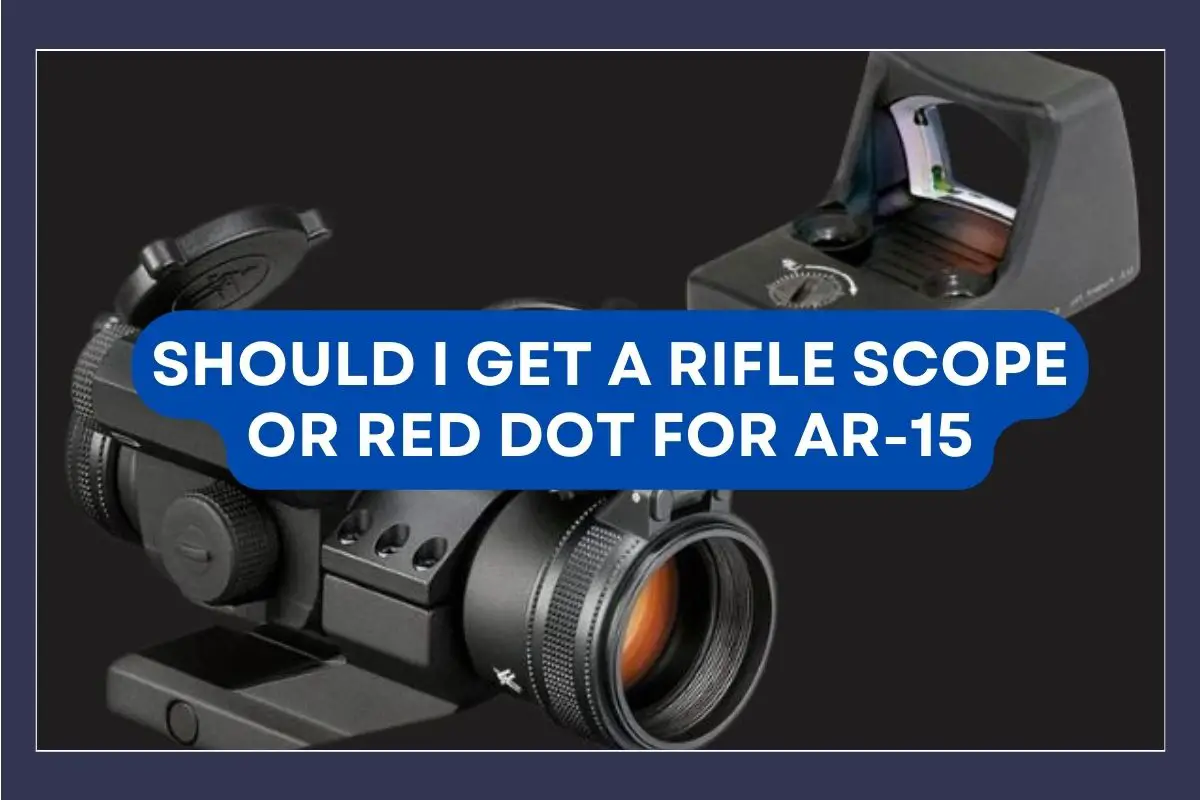Choosing optics for an AR-15 can be tricky. Rifle scopes and red dots are popular choices, each with their own strengths. The best option depends on your intended use, with scopes better for long-range precision and red dots excelling at quick target acquisition up close.
Scopes offer magnification, making them ideal for shooters who need to engage targets at longer distances. They allow for more precise aiming but can be slower to use at close range. Red dots, on the other hand, are faster to acquire targets with and work well for close to medium ranges.
Your shooting style and typical engagement distances will guide your choice. Consider factors like weight, durability, and cost when deciding. Both types of optics can enhance your AR-15’s performance when chosen wisely.
Key Takeaways
- Scopes are best for long-range precision shooting
- Red dots excel at quick target acquisition for close-range use
- Choose based on your shooting needs, budget, and preferred features
Understanding Rifle Optics
Rifle optics help shooters aim more accurately at targets. They come in different types to suit various shooting needs and preferences.
Types of Rifle Scopes
Rifle scopes use magnification to make distant targets appear closer. Fixed scopes have one set magnification level, like 4x or 6x. Variable scopes let shooters adjust the magnification, such as 3-9x or 4-16x.
Some scopes have illuminated reticles for low-light use. Others feature bullet drop compensators to adjust for long-range shots. First focal plane scopes keep the reticle size consistent as magnification changes.
Scopes work well for precision shooting at longer ranges. They’re great for hunting and target practice beyond 100 yards.
Benefits of Red Dot Sights
Red dot sights project a small dot onto a lens for aiming. They don’t magnify the target but make it easy to aim quickly.
These sights work best for close-range shooting, typically under 100 yards. They’re ideal for home defense, competitive shooting, and hunting in thick brush.
Red dots allow faster target acquisition than scopes. Shooters can keep both eyes open, improving situational awareness. Many red dots have long battery life and are very durable.
Some red dots pair with magnifiers for more versatility. This combo gives shooters both close and mid-range capabilities.
Comparing Scope and Red Dot for AR-15
Scopes and red dots offer different benefits for AR-15 users. Each option has strengths that can enhance shooting performance in specific situations.
Accuracy and Range
Scopes excel at long-range accuracy. They magnify targets, making it easier to aim at distant objects. Most AR-15 scopes offer 3-9x magnification, ideal for shots beyond 100 yards.
Red dots shine in close to medium ranges. They have no magnification but provide a clear aiming point. This works well for targets up to 100 yards away.
Scopes let shooters see fine details on targets. This helps with precise shot placement. Red dots are less precise but still effective for center mass hits.
Speed and Target Acquisition
Red dots are faster for target acquisition. The dot appears on the target as soon as the shooter looks through the sight. This speed is great for moving targets or quick shots.
Scopes take more time to line up. Shooters must adjust their eye position to see clearly through the scope. This extra step slows down target acquisition.
Red dots have a wider field of view. This helps spot targets quickly. Scopes have a narrower view, which can make finding targets harder.
Versatility and Usage Scenarios
Scopes are best for hunting and long-range shooting. They help identify targets and make accurate shots at a distance. Scopes also work well in low-light conditions.
Red dots excel in close-quarters combat and home defense. They allow for quick target acquisition and shooting with both eyes open. This is helpful in fast-paced situations.
Some shooters use both. They mount a scope for long-range shots and add a small red dot for close targets. This setup offers flexibility for different shooting needs.
Mounting Considerations
Proper mounting is key for both rifle scopes and red dots on an AR-15. It affects accuracy, durability, and ease of use.
Compatibility and Installation
AR-15s have a Picatinny rail on top for attaching optics. Most scopes and red dots are made to fit this rail. Scope mounts come in different heights. Choose one that aligns the scope with your eye when you shoulder the rifle.
Red dots often have a built-in mount. Some need a separate riser to sit at the right height. Always check that the mount is tight and secure. Use a torque wrench to tighten screws to the maker’s specs.
Maintaining Zero
A good mount keeps your optic “zeroed” or on target. Cheap or loose mounts can shift, making your shots miss. Look for mounts made of strong materials like aluminum.
Some mounts have a quick-detach feature. This lets you take off the optic and put it back on without losing zero. It’s handy for cleaning or switching optics.
Recoil can affect zero over time. Check your optic’s zero regularly, especially after rough handling. Re-tighten mount screws as needed.
Durability and Maintenance
Rifle scopes and red dots differ in their construction and upkeep needs. The choice impacts how well the optic holds up over time and how much care it requires.
Construction and Materials
Rifle scopes often use aluminum or steel tubes. These materials resist impacts and harsh weather. Many scopes have nitrogen or argon gas inside to prevent fogging. O-rings seal out moisture and dust.
Red dot sights have simpler builds. They use lightweight materials like polymer or aluminum. This makes them less likely to break if dropped. But it also means they may not handle extreme abuse as well as some scopes.
Both types of optics use coated glass lenses. These coatings protect against scratches and glare. Higher-end models tend to use better materials and more durable coatings.
Ease of Cleaning and Care
Rifle scopes need careful handling. Their longer tubes and multiple lenses require more attention. Users should clean the outer lenses gently with a soft cloth. Avoid touching internal parts.
Red dots are easier to maintain. They have fewer parts and only one lens to clean. A quick wipe of the lens is often all that’s needed.
Both types benefit from lens covers when not in use. This protects against dust and scratches. Store optics in a dry place to prevent moisture damage.
Regular checks for loose screws or mounts help keep both types working well. Apply a tiny bit of thread-locking compound on screws to keep them tight.
Budget and Value for Money
Cost and long-term value are key factors when choosing between rifle scopes and red dots for an AR-15. Each option has different price points and benefits to consider.
Cost Comparison
Rifle scopes tend to be more expensive than red dot sights. A basic red dot can cost $50-$200, while entry-level scopes start around $100-$300. Mid-range options for both fall in the $300-$800 range. High-end scopes can exceed $2000, but premium red dots rarely top $1000.
Red dots are simpler, with fewer parts to manufacture. This leads to lower prices. Scopes have more complex optics and adjustments, driving up costs.
Long-Term Investment
Scopes often last longer than red dots. Quality scopes can function for decades with proper care. Red dots may need battery replacements and can fail sooner.
Scopes retain value better over time. A good scope can be moved to different rifles as needs change. Red dots are less versatile, potentially limiting their long-term usefulness.
Training time is another factor. Mastering a scope takes longer, but the skills transfer to other optics. Red dot proficiency comes quicker but has less carry-over to other sights.
Frequently Asked Questions
Choosing between a rifle scope and red dot sight for an AR-15 involves weighing factors like magnification, target acquisition speed, and intended use. Each option has pros and cons that affect accuracy, versatility, and overall shooting experience.
What are the benefits of using a rifle scope over a red dot sight for my AR-15?
Rifle scopes offer magnification for better accuracy at longer ranges. They let shooters see targets in more detail. Scopes also have adjustable reticles for improved precision.
Can a red dot sight be used effectively for long-range shooting with an AR-15?
Red dot sights work best for close to medium ranges. They lack magnification, making long-range shots harder. Some models can be paired with magnifiers for extended reach.
How do magnification levels differ between rifle scopes and red dot sights when using an AR-15?
Rifle scopes typically offer variable magnification, from low power to high power. Red dot sights usually have no magnification. This affects target visibility at different distances.
What are the key considerations when choosing between a rifle scope and a red dot for hunting with an AR-15?
For hunting, consider the typical shooting distance and environment. Scopes excel in open areas and longer ranges. Red dots are better for dense woods and close encounters.
How does a red dot sight impact the speed and accuracy of target acquisition compared to a rifle scope on an AR-15?
Red dot sights allow for faster target acquisition, especially at close range. They have a wider field of view. Scopes may slow down the process but offer more precision for distant targets.
Will the weight difference between a rifle scope and a red dot sight affect the handling of my AR-15?
Red dot sights are lighter than most rifle scopes. This can make the AR-15 easier to handle and carry. Heavier scopes may affect balance but often provide more stability when aiming.

